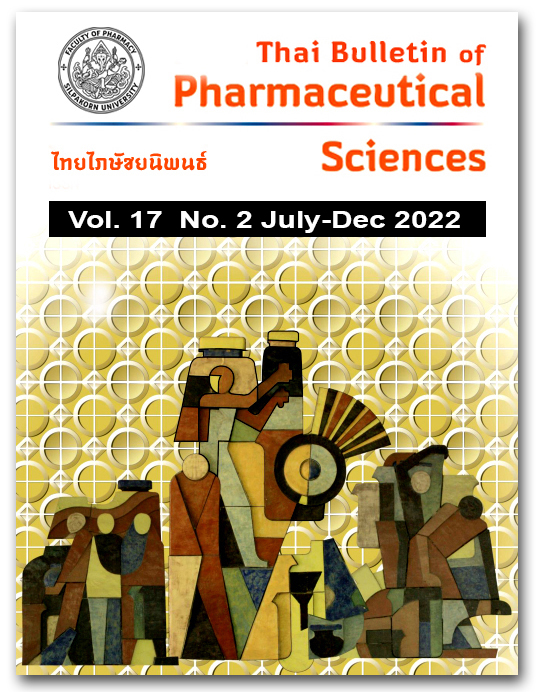DEVELOPMENT OF HYDROGEL CONTAINING BACTERIAL CELLULOSE AND PECTIN OR ALGINATE FOR WOUND DRESSING APPLICATIONS
DOI:
https://doi.org/10.69598/tbps.17.2.23-36Keywords:
Bacterial cellulose, hydrogel, cross-linking, alginate, pectinAbstract
This study aimed to develop hydrogel containing bacterial cellulose (BC) for pharmaceutical applications. 2 %w/v BC was mixed with alginate (A) or pectin (P) at different concentrations with weight ratios of 3:7, 4:6 and 5:5. After that, the blend was fabricated by casting onto a mold and cross-linking with a 3 %w/v of calcium chloride solution to form a hydrogel, followed by a freeze-drying process. The morphological characterization, fluid uptake ability, swelling degree, water retention property and integrity value were evaluated. Our results show that 3-part of 2 %w/v BC mixed with 7-part of A or P at the concentrations
0.5 (BC2A0.5-1) and 5 %w/v (BC2P5-1) were the optimized concentration. The morphological characterization of BC2P5-1 showed a smooth surface, unlike BC2A0.5-1, which offered a fluff surface. The thickness and diameter of BC2A0.5-1 were lower than BC2P5-1 due to structural shrunk when cross-linking with 3 %w/v CaCl2 solution, but the hardness of BC2A0.5-1 was higher than BC2P5-1, while scanning electron microscope images showed no significant difference. Fluid uptake ability, swelling degree, water retention property and integrity value of BC2A0.5-1 cannot be evaluated because its structure was segregated after being soaked in phosphate buffer saline for 24 h. However, the fluid uptake ability and swelling degree of BC2P5-1 trended to increase and reached the equilibrium point after 8 h, and the water retention property trended to decrease and was constant after 10 h. Integrity value of BC2P5-1 was 30.85±0.50 %. In conclusion, the BC2P5-1 showed better properties than
BC2A0.5-1. Thus BC2P5-1 can be further developed as a prototype wound dressing.
References
Endler A, Schneider R, Kesten C, Lampugnani ER, Persson S. The Cellulose synthase companion proteins act non-redundantly with cellulose synthase interacting1/POM2 and cellulose synthase 6. Plant Signal Behav. 2016;11(4):e1135281.
Klemm D, Heublein B, Fink HP, Bohn A. Cellulose: fascinating biopolymer and sustainable raw material. Angew Chem Int Ed. 2005;44(22):3358–93.
Ross P, Mayer R, Benziman M. Cellulose biosynthesis and function in bacteria. Microbiol Rev. 1991;55(1):35–58.
Wasilewska K, Winnicka K. Ethylcellulose-a pharmaceutical excipient with multidirectional application in drug dosage forms development. Materials. 2019;12(20):3386.
Gorgieva S, Trček J. Bacterial cellulose: production, modification and perspectives in biomedical applications. Nanomaterials. 2019;9(10):1352.
Hu W, Chen S, Yang J, Li Z, Wang H. Functionalized bacterial cellulose derivatives and nanocomposites. Carbohydr Polym. 2014;101:1043–60.
Sannino A, Demitri C, Madaghiele M. Biodegradable cellulose-based hydrogels: design and applications. Materials. 2009;2(2):353–73.
Swingler S, Gupta A, Gibson H, Kowalczuk M, Heaselgrave W, Radecka I. Recent advances and applications of bacterial cellulose in biomedicine. Polymers. 2021;13(3):412.
Mohamad N, Loh E, Fauzi MB, Ng MH, Mohd AM. In Vivo evaluation of bacterial cellulose/acrylic acid wound dressing hydrogel containing keratinocytes and fibroblasts for burn wounds. Drug Deliv Transl Res. 2019;9(2):444–52.
Hennink WE, van Nostrum CF. Novel crosslinking methods to design hydrogels. Adv Drug Deliv Rev. 2002;54(1):13-36.
Bhattarai N, Gunn J, Zhang M. Chitosan-based hydrogels for controlled, localized drug delivery. Adv Drug Deliv Rev. 2010;62(1):83–99.
Hoare TR, Kohane DS. Hydrogels in drug delivery: progress and challenges. Polymer. 2008;49(8):1993–2007.
Vlaia L, Coneac G, Olariu I, Vlaia V, Lupuleasa D. Cellulose-derivatives-based hydrogels as vehicles for dermal and transdermal drug delivery. IntechOpen. 2016;2(2):64–70.
Phisalaphong M, Suwanmajo T, Tammarate P. Synthesis and characterization of bacterial cellulose/alginate blend membranes. J Appl Polym Sci. 2008;107:3419-24.
Sulaeva I, Hettegger H, Bergen A, Rohrer C, Kostić MM, Konnerth J, Rosenau T, Potthast A. Fabrication of bacterial cellulose-based wound dressings with improved performance by impregnation with alginate. Mater Sci Eng C. 2020;110:110619.
Li J, Fenglun Z, Liwei Z, Jianxin J. An In-situ fabrication of bamboo bacterial cellulose/sodium alginate nanocomposite hydrogels as carrier materials for controlled protein drug delivery. Int J Biol Macromol. 2021;170:459-68.
Chen W, Yuan S, Shen J, Chen Y, Xiao Y. A Composite hydrogel based on pectin/cellulose via chemical cross-linking for hemorrhage. Front Bioeng Biotechnol. 2021;8:627351.
Lopez SP, Martinez SM, Bonilla MR, Wang D, Gilbert EP, Stokes JR, Gidley MJ. Cellulose-pectin composite hydrogels: intermolecular interactions and material properties depend on order of assembly. Carbohydr Polym. 2017;162:71–81.
Fan F, Saha S, Hanjaya-Putra D. Biomimetic hydrogels to promote wound healing. Front Bioeng Biotechnol. 2021;9:718377.
Jones V, Grey JE, Harding KG. Wound dressings. BMJ. 2006;332(7544):777-80.
Brumberg V, Astrelina T, Malivanova T, Samoilov A. Modern wound dressings: hydrogel dressings. Biomedicines. 2021;9(9):1235.
Kuo CK, Ma PX. Maintaining dimensions and mechanical properties of ionically crosslinked alginate hydrogel scaffolds in vitro. J Biomed Mater Res A. 2008;84(4):899-907.
Salisu A, Sanagi MM, Abu NA, Wan IWA, Karim KJ. Removal of lead ions from aqueous solutions using sodium alginate-graft-poly(methyl methacrylate) beads. Desalination Water Treat. 2016;57(33):1-9.
Gao C, Liu M, Chen J, Zhang X. Preparation and controlled degradation of oxidized sodium alginate hydrogel. Polym Degrad Stab. 2009;94:1405-10.
Wang H, Chen X, Wen Y, Li D, Sun X, Liu Z, Yan H, Lin Q. A Study on the correlation between the oxidation degree of oxidized sodium alginate on its degradability and gelation. Polymers. 2022;14(9):1679.
Mohite BV, Koli SH, Patil SV. Bacterial cellulose-based hydrogels: synthesis, properties, and applications. Polym Polym Compos A Ref Ser. 2019:1255–76.
Downloads
Published
How to Cite
Issue
Section
License
All articles published and information contained in this journal such as text, graphics, logos and images is copyrighted by and proprietary to the Thai Bulletin of Pharmaceutical Sciences, and may not be reproduced in whole or in part by persons, organizations, or corporations other than the Thai Bulletin of Pharmaceutical Sciences and the authors without prior written permission.



